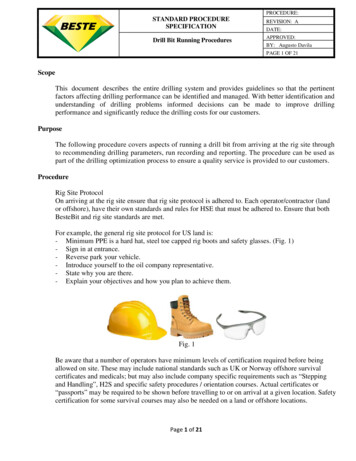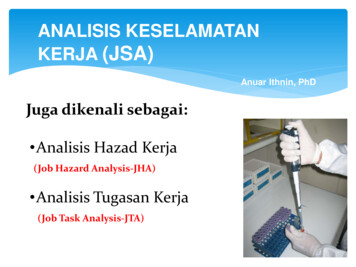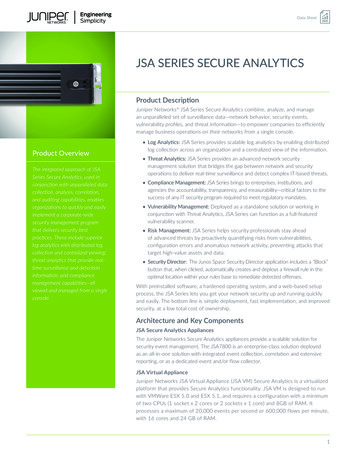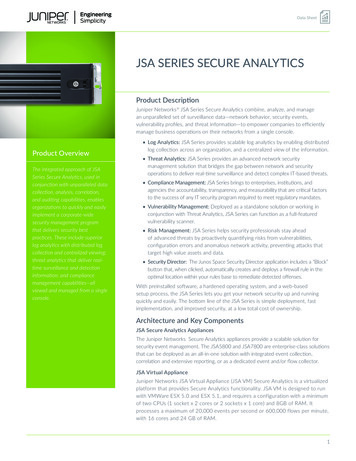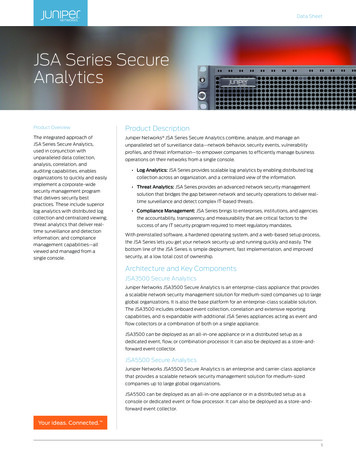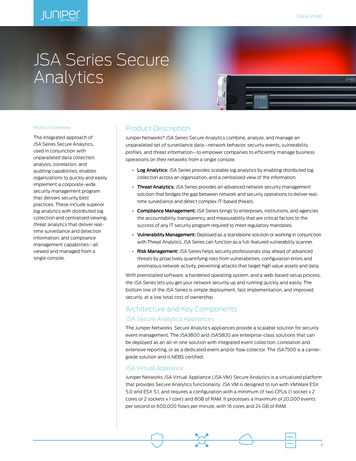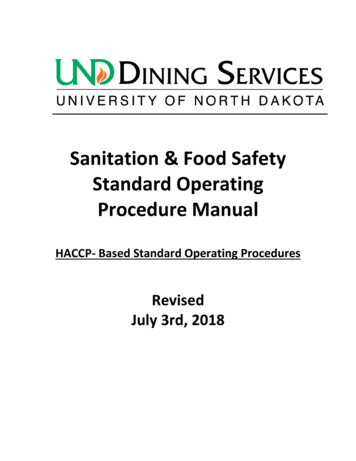
Transcription
Document TitleThe Tata Power Company LtdJob Safety Analysis (JSA)ProcedureDocument Ref No:Date of Issue: 01/01/2016TPSMS/CSP/JSA/009 Rev 01JOB SAFETY ANALYSIS (JSA) PROCEDURERev No.Reason for RevisionPrepared ByChecked ByApproval byRev 00Initial ReleaseNavendra SinghSanjay KaleShrinivas KattiRev 01To implement Tata Power JSAStandardNote: Uncontrolled once printedNavendra Singh(Group Head – P &CB; Corp Safety.)Rajesh Sharma(Head – Crop.Safety Operation)Vijay Chourey(Chief – Corp Safety)Page 1 of 7
Document TitleThe Tata Power Company LtdJob Safety Analysis (JSA)ProcedureDocument Ref No:Date of Issue: 01/01/2016TPSMS/CSP/JSA/009 Rev 01ContentsSectionDescriptionPage No.1.0OBJECTIVE32.0SCOPE33.0EXPECTED RESULTS34.0ACCOUNTABILITY & RESPONSIBILTIY35.0GLOSSARY/ DEFINITIONS46.0PROCEDURES47.0RECORDS58.0TRAINING & ure – 1: Sample Format for Job Safety Analysis (JSA) -7-TPSMS/CSP/JSA/009/FORM/001Note: Uncontrolled once printedPage 2 of 7
Document TitleThe Tata Power Company LtdDocument Ref No:TPSMS/CSP/JSA/009 Rev 01Job Safety Analysis (JSA)ProcedureDate of Issue: 01/01/20161. OBJECTIVE: Objective of this procedure is to have a task/job based risk assessmentprocess in place that identifies, evaluates and controls the risks associated with workactivities, and as a result, prevents those involved in the task or those potentially affectedby the task, from being harmed.2. SCOPE: This procedure applies to all operating and project sites of Tata Power Groupcompanies. A JSA (Job Safety Analysis) Shall be carried out:2.1. When new / different people will be undertaking the job for which an SOP / SMP isavailable2.2. When a non-routine task is to be undertaken2.3. When Job to be executed under Permit-To-Work (PTW)2.4. When deviations, due to some specific reasons, are required for Standard Operatingprocedure (SOP) / SMP (Standard Maintenance Procedure)2.5. Whenever a job with a Standard Operating procedure (SOP) / SMP (StandardMaintenance Procedure) is being undertaken in circumstances where the conditionsof the job are changed with respect to the SOP/SMP. e.g. A welder working in hisfabrication area will be covered by a SOP with HIRA already carried out, however, ifthe welding is being done on the site at a height or a confined space or in an areawhich may interfere with other jobs we need to conduct a JSA and use this inconjunction with the HIRA (Hazard Identification Risk Assessment) for the weldingactivity.3. EXPECTED RESULTS:3.1. Manage Non routine jobs being done under permit-to-work safe.3.2. Manage Routine jobs being done under SOP/SMP.3.3. Control of incidents related to Routine & Non routine Jobs.3.4. Compliance to Regulatory requirements to make work place safety4. ACCOUNTABILITY & RESPONSIBILITY:4.1. ACCOUNTABILITY: Concerned Division’s Heads / Assets Custodian.4.2. RESPONSIBILITY: Concerned EngineerNote: Uncontrolled once printedPage 3 of 7
Document TitleThe Tata Power Company LtdDocument Ref No:TPSMS/CSP/JSA/009 Rev 01Job Safety Analysis (JSA)ProcedureDate of Issue: 01/01/20165. GLOSSARY/ DEFINITIONS:Hazard Identification & Risk Assessment: Hazard Identification & Risk Assessment isto identify and evaluate the hazards, Risk and put controls measures for safe execution ofactivities.Hazard: Source or situation with potential for harm, something that can cause body injury/ occupational illness, damage company property.Job: A piece of physical work defined by time or other limits and that has a clear start andend pointJob Safety Analysis: Job safety analysis (JSA) is a procedure which helps integrateaccepted safety and health principles and practices into a particular task or job. In a JSA,for each basic step of the job, it is to identify potential hazards and to recommend thesafest way to do the job.Non Routine Job / Task: Where an SOP / SMP is not available or the conditions of theSOP / SMP have changedRisk Assessment: A systematic and structured process whereby hazards present in aworkplace, or arising from workplace activity, are identified, risks assessedRisk: The likelihood (probability) which can lead to potential negative consequences.Severity: The level of consequence / harm of an event that could occur due to exposureto the hazard presentSOP: Standard Operating ProcedureSMP: Standard Maintenance ProcedureShall: Mandatory requirementShould: Optional requirementTask / Activity: A sequence of steps taken to conduct a job. A task is a sub element ofa Job.6. PROCEDURES6.1. The following criteria shall be used in determining whether HIRA or JSA will berequired. Following illustrations may be useful to understand between selection ofHIRA and JSA.6.1.1. HIRA is activity specific like use of OXY-Acetylene Set for cutting.6.1.2. JSA is Job specific like cutting of steam tubes using OXY-Acetylene set in theboiler6.1.3. HIRA is Quantitative while JSA is Qualitative6.1.4. HIRA primarily contain hazard & control measures specific to tools &equipment’s and methodology to be used for the activity.6.1.5. JSA contain hazards and control measure including to activity and siteconditions where job to be accomplished.Note: Uncontrolled once printedPage 4 of 7
Document TitleThe Tata Power Company LtdDocument Ref No:TPSMS/CSP/JSA/009 Rev 01Job Safety Analysis (JSA)ProcedureDate of Issue: 01/01/20166.2. For methodology and details about HIRA refer Tata Power Hazard Identification &Risk Assessment (HIRA) Procedure (TPSMS/GSP/HIRA/005).6.3. Job Safety Analysis (JSA) involves the following:6.3.1. Determining the scope of the job and listing the steps in the job.6.3.2. Identifying possible hazards in the job.6.3.3. Determining who and/or what is at potential risk6.3.4. Describing the recommended safe way to do the job in order to preventincidents and injuries.6.3.5. Anticipating what might go wrong and devising back-up controls.6.4. This will help to:6.4.1. Identify and address hazards.6.4.2. Prevent incidents and injuries.6.4.3. Get organized to do the job right and more efficiently.6.4.4. Create procedures that can be used by everyone.6.4.5. Get people in the habit of working safely.6.5. Key Steps: The Job Safety Analysis consists of the following 6 steps:Step 1: Describe the job and the sequence of job stepsStep 2: Identification of the potential hazards of each stepStep 3: Determine who and/or what is at potential riskStep 4: Description of the recommended safe job procedureStep 5: Identification of what might go wrongStep 6: Identification of back up controlsJSA should be done using SAP-EHS Modules. Alternatively it can be done usingabove 6 steps and format given in the Annexure 1.6.6. Team Composition: The JSA is generally carried out by a team comprising;6.6.1. Person/Team who do the work6.6.2. Person supervising the job6.6.3. Person with safety knowledge6.6.4. Person (Specialist/Consultant) with technical knowledge6.6.5. The number of team members will depend on and vary with the complexity ofthe job.7. RECORDS :7.1. Job safety analysis (JSA) (TPSMS/CSP/JSA/009/FORM/001)- Retention 12 Months8. TRAINING & COMMUNICATION8.1. Training of procedure shall be covered along with Permit-To-Work (PTW) procedureas Safety Training Needs identified.Note: Uncontrolled once printedPage 5 of 7
Document TitleThe Tata Power Company LtdDocument Ref No:TPSMS/CSP/JSA/009 Rev 01Job Safety Analysis (JSA)ProcedureDate of Issue: 01/01/20168.2. Initial Communication to be done through Corporate Communication, Email andsubsequently shall be made available at safety portal at Sangam.9. VERIFICATION9.1. Verification of implementation shall be done during Permit-To-Work (PTW) audit, fieldsafety visit and site inspections.10. EXCEPTION: Any exception to this procedure Any Exception to this procedure shall onlybe done as per Document Control .Procedure (TPSMS/GSP/DC/014).11. REFERENCES Tata Group Job Safety Analysis (JSA) Standard Tata Power Permit-To-Work (PTW) procedure (TPSMS/CSP/PTW/008) Tata Power Hazard Identification & Risk Assessment (HIRA) Procedure(TPSMS/GSP/HIRA/005)12. REVIEW: Review of this procedure shall be done as and when but not later than once inevery three (03) years. Typical Factors like Changes in legislation, Review of IncidentReports, Inspection & Audit findings, Feedback from users, Recommendations in Incidentinvestigation reports may be inputs for the review and revision of the procedure.13. ATTACHMENTS/APPENDIX :13.1. Annexure – 1: Sample Format for Job Safety Analysis (JSA)(TPSMS/CSP/JSA/009/FORM/001)Note: Uncontrolled once printedPage 6 of 7
Document TitleThe Tata Power Company LtdDocument Ref No:TPSMS/CSP/JSA/009 Rev 01Job Safety Analysis (JSA)ProcedureDate of Issue: 01/01/2016Annexure - 1TPSMS/CSP/JSA/009/FORM/001All above activities, Hazards, Controls have been explained to M/Sand are required to be followed by M/s .Note: Uncontrolled once printedPage 7 of 7
the welding is being done on the site at a height or a confined space or in an area which may interfere with other jobs we need to conduct a JSA and use this in conjunction with the HIRA (Hazard Identification Risk Assessment) for the welding activity. 3. EXPECTED RESULTS: 3.1. Manage Non routine jobs being done under permit-to-work safe.File Size: 579KBPage Count: 7





